USD-INR Trading In The Forex Market – Top Strategies
The best USD-INR trading strategies are:
-
-
-
Range trading strategy
-
-
As the exchange rate between the United States Dollar (USD) and the Indian Rupee (INR) continually shifts, employing well-informed trading approaches becomes important for traders aiming to make the most out of its opportunities and mitigate risks. In this comprehensive guide, the experts at TU delve into an analysis of strategies tailored to USD-INR trading.
Do you want to start trading Forex? Open an account on Roboforex!What is USD-INR trading?
USD-INR trading involves the exchange of the United States Dollar (USD) and the Indian Rupee (INR), playing a significant role in the global foreign exchange market. This trading practice revolves around the buying and selling of these two currencies, with the goal of profiting from their ever-shifting exchange rates. Traders carefully monitor and analyze market trends, seizing opportunities to optimize profits through well-thought-out transactions within this currency pair.
USD-INR trading is a popular currency pair among traders, attracting a diverse range of participants, including individual traders, financial institutions, multinational corporations, and central banks. The exchange rate between USD and INR is influenced by a multitude of factors, including economic indicators, geopolitical occurrences, monetary policies, and prevailing market sentiment. These forces come together to create a dynamic landscape for traders to navigate.
Best USD-INR trading strategies
Trend trading strategy
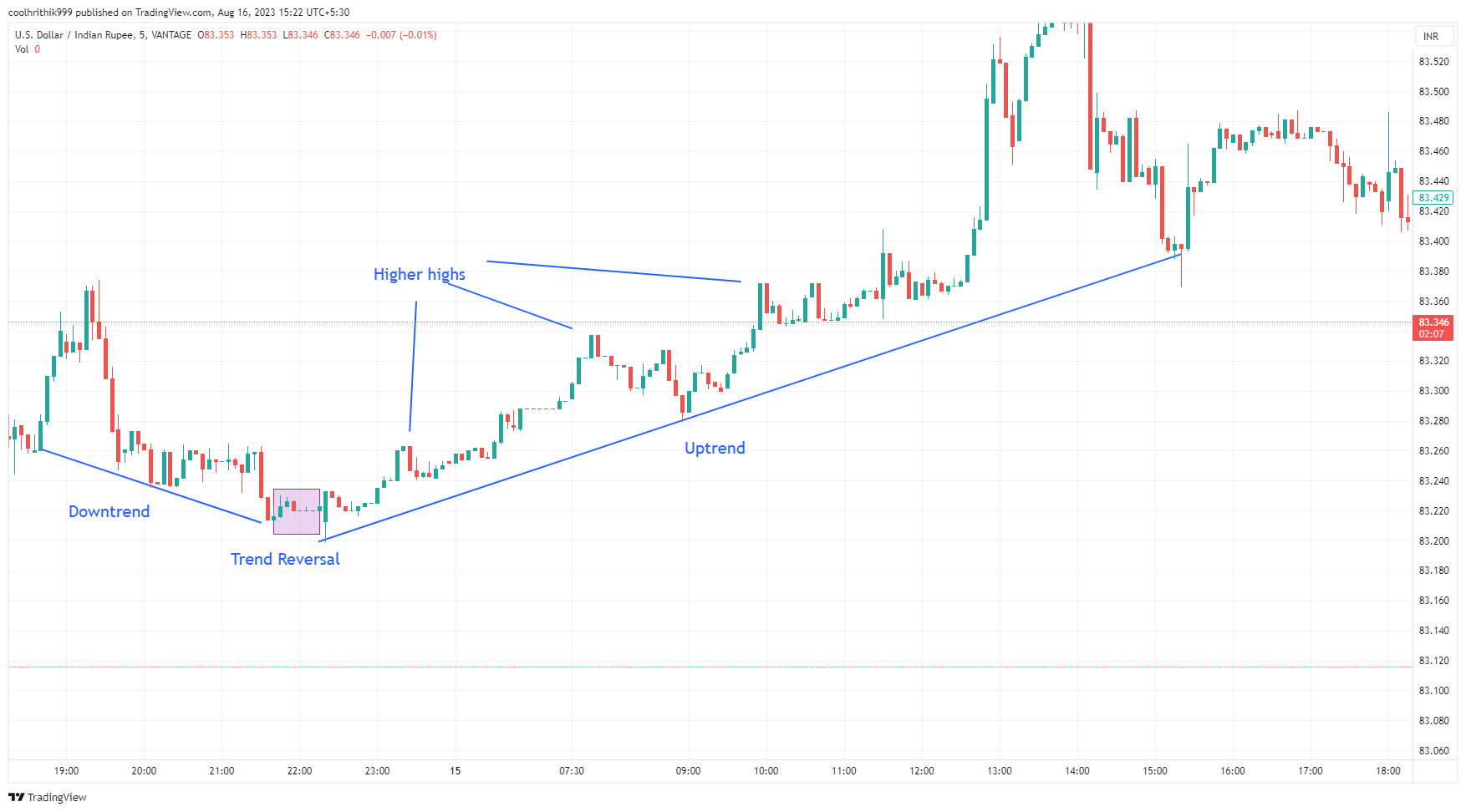
Trend Trading Illustration – USD-INR Trading
The trend trading strategy is very important in USD-INR trading and is one of the more effective ones. In this strategy, traders must align their positions with the prevalent market trends. By looking at the currency price movements, traders predict the trajectory of the trends and then make calculated entry decisions. This strategy works on the premise that markets exhibit directional biases, and by riding these trends, traders can obtain substantial profit potential.
By identifying higher highs (HH) and higher lows (HL) in an uptrend or lower highs (LH) and lower lows (LL) in a downtrend, traders predict the market's prevailing direction. Through this knowledge, they enter positions that align with the trend’s momentum. This strategy also has an added benefit, it allows the advantage of riding extended price movements whilst minimizing temporary drawdowns or price fluctuations.
Observe the illustration. A trend trader would first engage in a short trade while the price is in downtrend, and once the trend reversal is identified, they would switch their positions and enter a long trade. The ultimate goal is to match one’s position with the direction of the market.
However, it is important to note that these trends can change unexpectedly. Therefore, traders should employ supplementary tools such as technical indicators or fundamental analysis to validate trend assessments and manage positions rather effectively.
Breakout trading
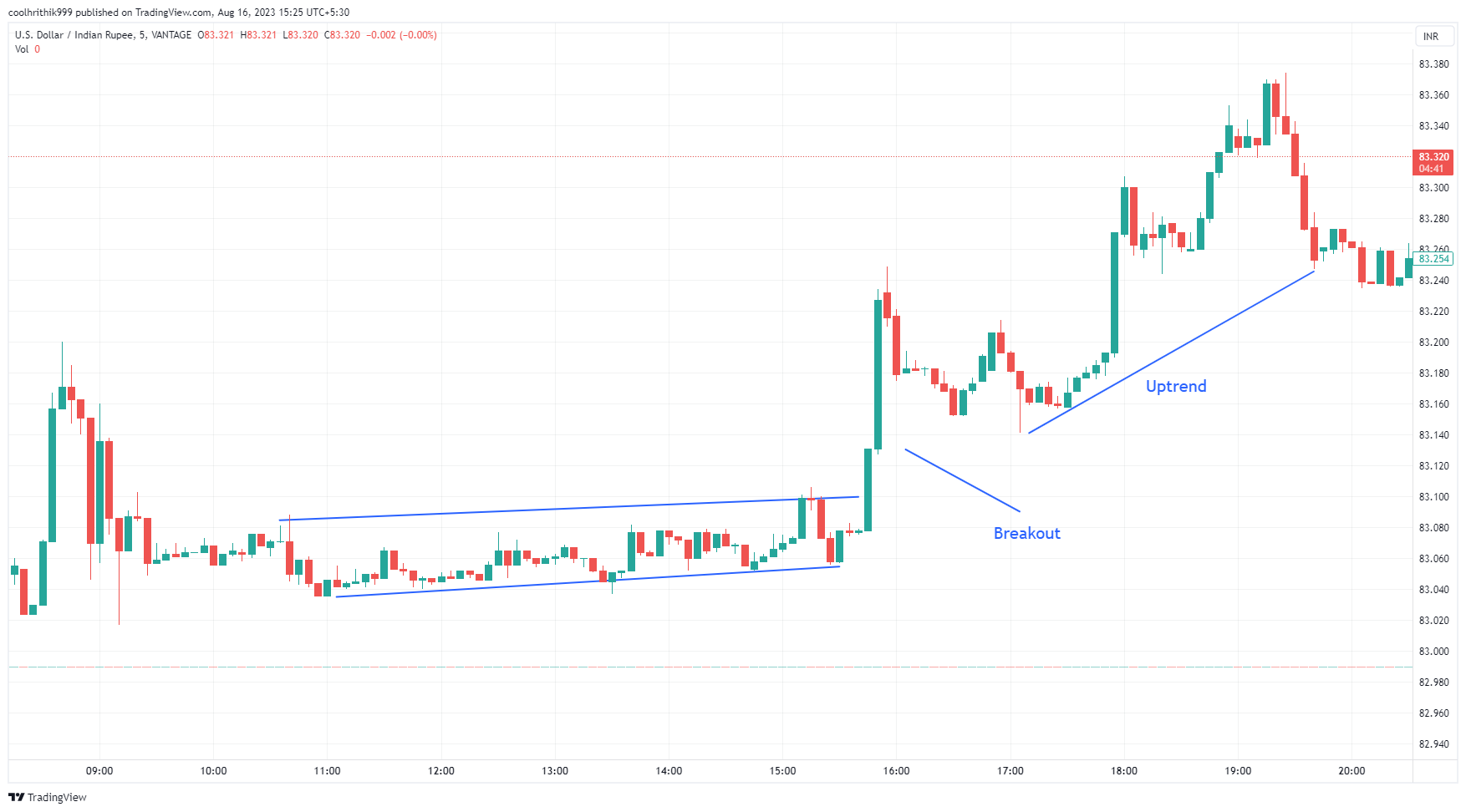
Breakout Trading Illustration – USD-INR Trading
Breakout trading is a strategy wherein traders identify significant price movements beyond established trading ranges (particularly support and resistance levels). When prices breach these levels, traders enter the market with the expectation that these breakouts will then lead to extended price movements in the same direction.
This strategy hinges on the notion that these breakout moments signal a shift in market sentiment, or that a new trend will emerge. By entering positions during these breakouts, traders seek to capitalize on potential price momentum and the continuation of the new trend.
To implement this strategy, traders must carefully monitor price consolidation patterns and identify breakout points. One common approach is to wait for a confirmed breakout, typically marked by a decisive price close beyond a resistance or support level. Stop-loss orders are crucial in breakout trading to manage potential losses if the price reverses after the breakout.
While breakout trading offers the chance of capturing strong market movements, false breakouts can occur. Traders must exercise prudence by using additional indicators and confirming factors before committing to trades.
Range trading
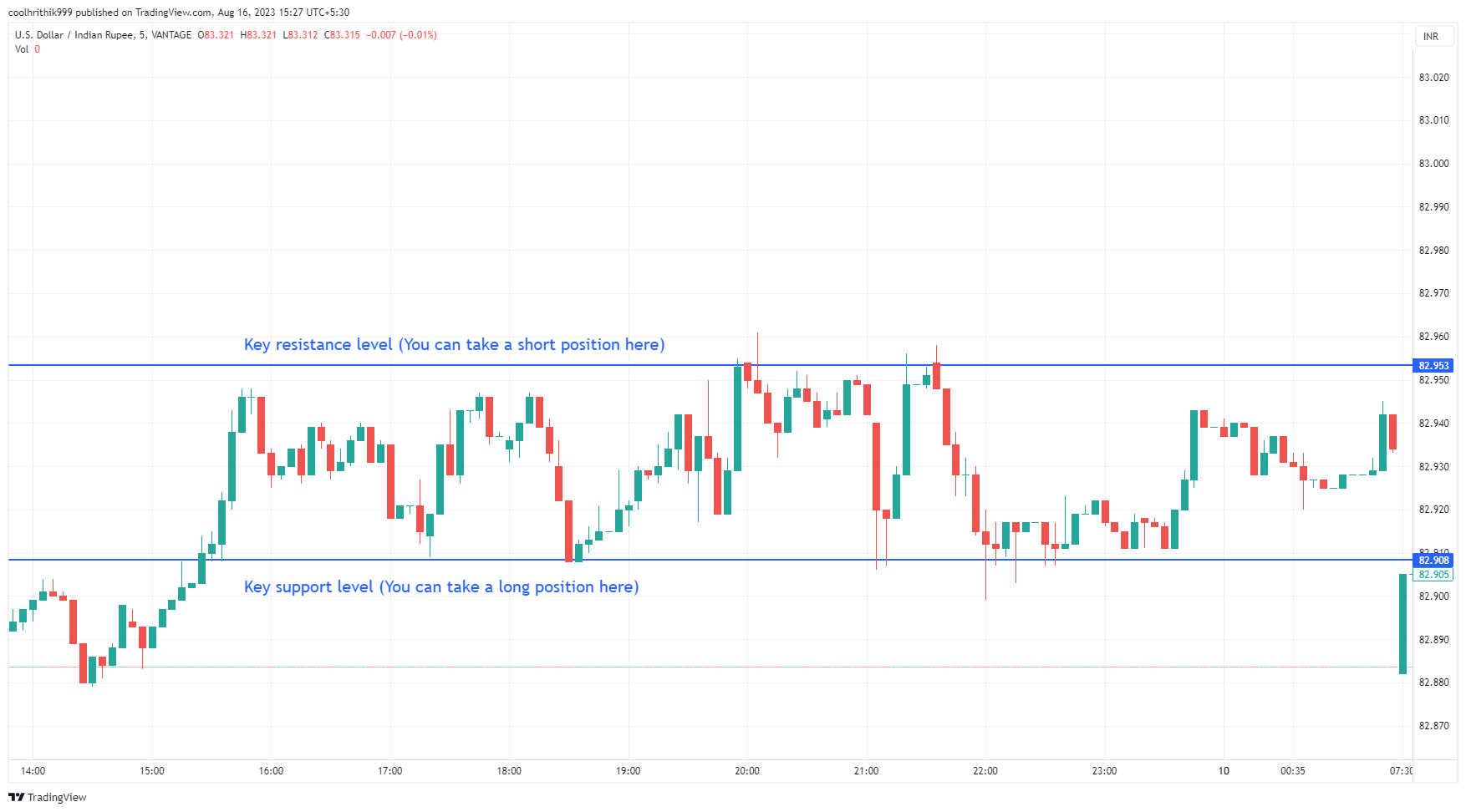
Range Trading Illustration – USD-INR Trading
Range trading, also known as horizontal trading, revolves around identifying specific support and resistance levels within which the currency pair's exchange rate oscillates. This strategy is particularly useful when markets lack a clear trend and exhibit sideways movement.
Traders practicing range trading seek to capitalize on price reversals within the established range. They initiate buy positions near support levels and sell positions close to resistance levels. The goal is to profit from the predictable price fluctuations within the range.
This strategy demands a thorough understanding of support and resistance levels, as well as an ability to identify potential breakout points. Traders should remain vigilant for signs of price reversal, such as candlestick patterns or the weakening of the prevailing trend.
Range trading is often favored by traders who can skillfully interpret price patterns. However, it's crucial to note that ranges can eventually transform into trends, and traders must adapt their strategies accordingly.
Price action analysis
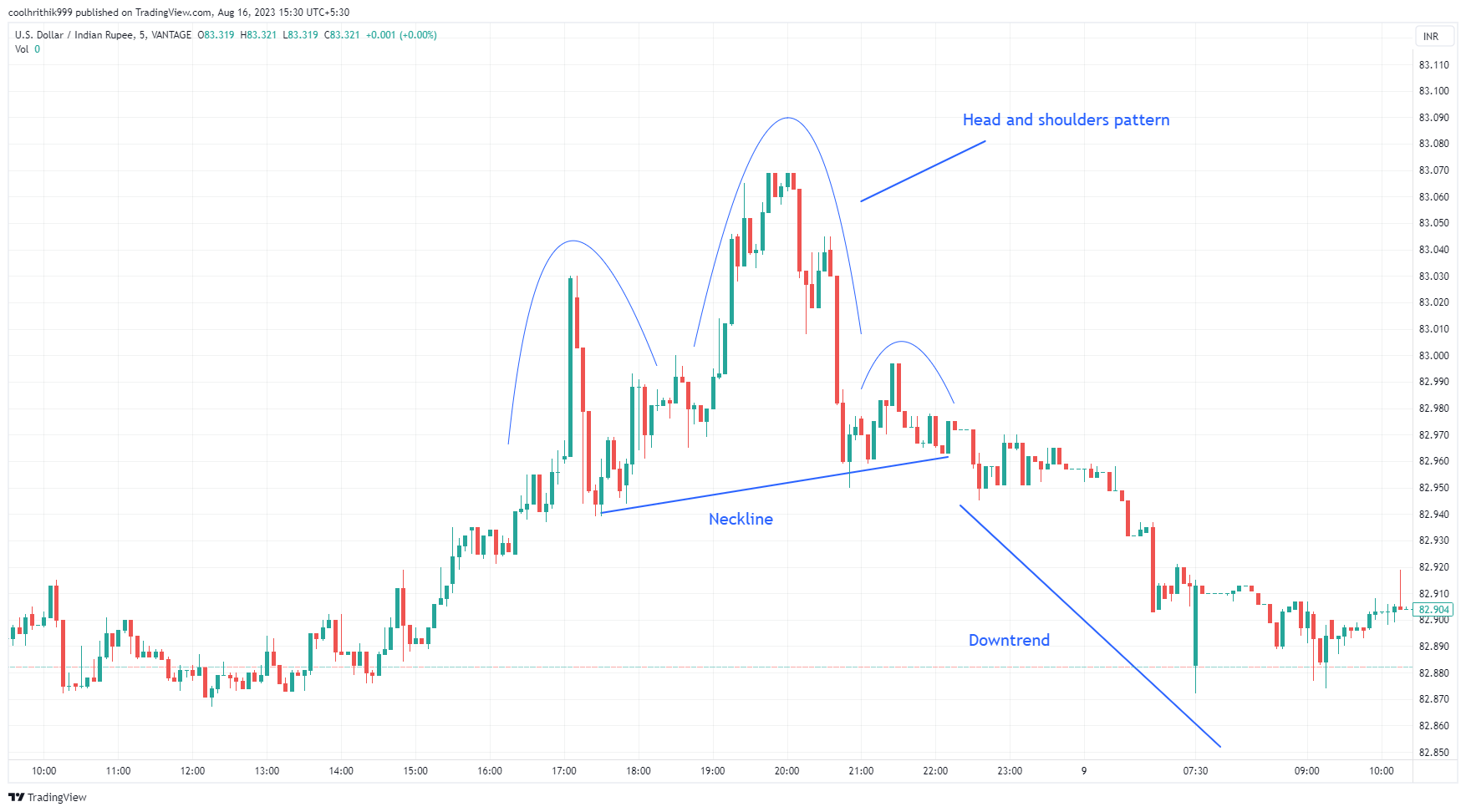
Price Action Illustration – USD-INR Trading
Price action analysis is a strategy that revolves around interpreting historical price movements and chart patterns to predict future price changes. This technique eliminates the use of complex indicators and focuses solely on studying price movement itself.
Traders who employ price action analysis look for patterns, such as head and shoulders, double tops, or flags, to anticipate potential price reversals or continuations. By observing the interplay of bullish and bearish candles, traders predict market sentiment and make informed decisions.
This strategy emphasizes the principle that historical price movements often repeat themselves due to the recurring influence of market psychology. Through careful observation of price patterns, traders aim to forecast future price movements with a higher degree of accuracy.
However, mastering price action analysis requires ample practice and a keen eye for detail. Traders must differentiate between genuine price signals and noise to effectively implement this strategy.
As you might observe in the illustration, the head and shoulders pattern formed for the USD-INR pair is somewhat imperfect. This is very common for trading pairs such as the USD-INR where traded volume is relatively on the lower side when compared to Forex majors. It thus calls for sharp knowledge of technical analysis if you wish to employ this strategy for the pair.
Moving averages (13-26) strategy
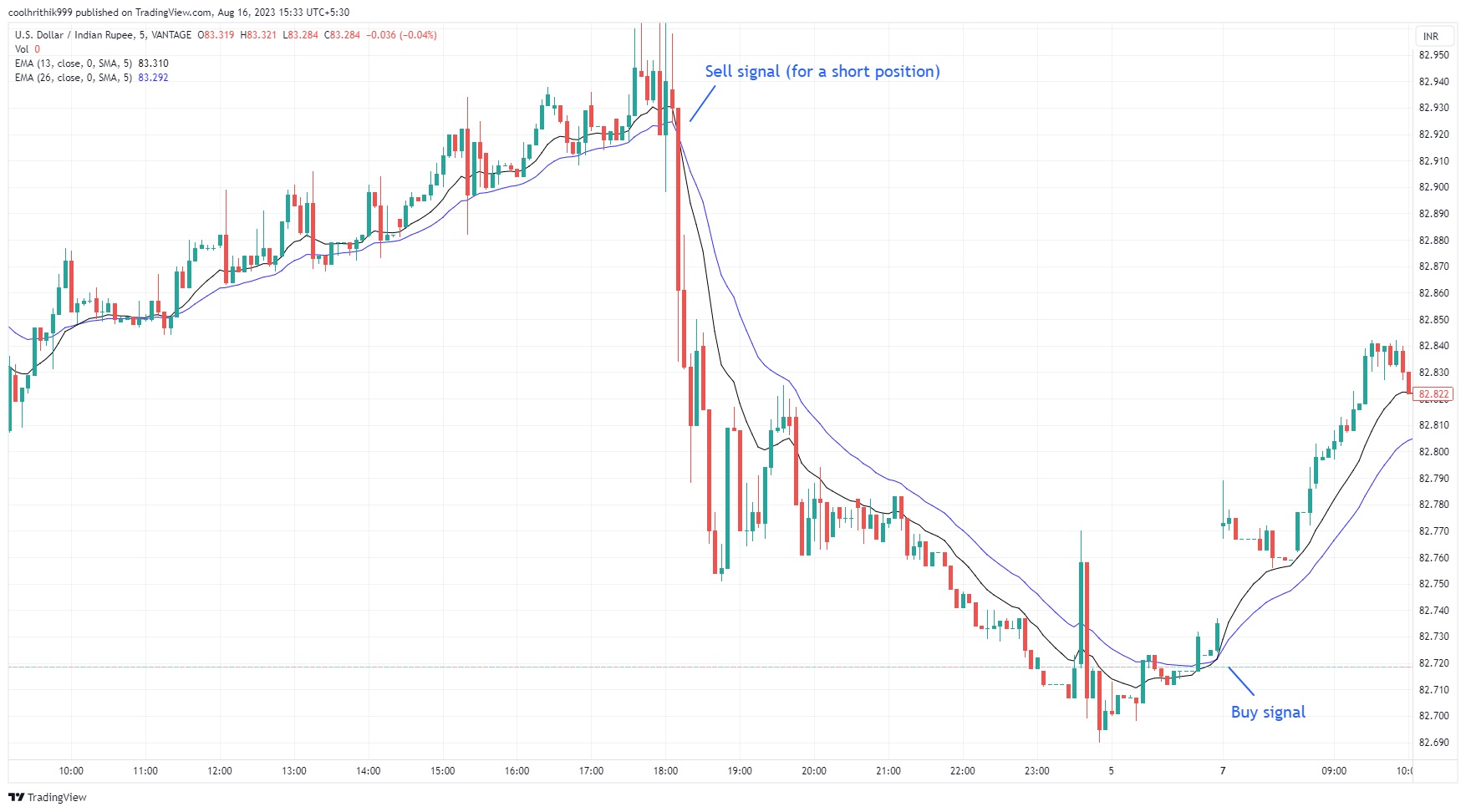
Moving Average Illustration – USD-INR Trading
Moving averages (MAs) are widely used technical indicators that smooth out price data to reveal underlying trends. The 13-26 moving average strategy involves employing two moving averages with different periods (13 and 26) to identify potential trend shifts and entry points.
When the shorter-period moving average crosses above the longer-period moving average, a potential bullish signal is generated, indicating a potential uptrend. Conversely, when the shorter-period moving average crosses below the longer-period moving average, a bearish signal suggests a potential downtrend.
The advantage of this strategy lies in its simplicity and ability to filter out short-term price fluctuations, revealing the overarching trend. It aids traders in entering positions that align with the prevailing market direction.
However, moving average strategies can lag during rapidly changing market conditions. Traders should combine this strategy with other indicators or techniques to enhance its effectiveness.
Best time to trade USD-INR
For Indian traders, the optimal window for Forex trading typically spans from 17:30 IST to 20:30 IST, aligning with the periods of heightened market activity and potential opportunity.
It's worth noting that Indian residents engaging in Forex trading must adhere to the guidelines established by the Foreign Exchange Management Act, 1999 (FEMA). These regulations permit trading activities solely with authorized professionals and for purposes that fall within the bounds of legality. Perhaps you are also interested in information about the best time to trade USD/INR
What affects USD-INR trading?
USD-INR trading is shaped by a range of factors that contribute to currency price movements. These include:
Economic and political conditions
The value of currencies can shift due to economic indicators and the political climate. Changes in economic growth, inflation, and employment, along with political developments, may materially impact the USD-INR exchange rate.
Forex market dynamics
The demand and supply of USD and INR in the global and domestic Forex markets play a significant role in determining their exchange rate. Market sentiment and trends contribute to price fluctuations.
Major events
Significant global events, such as geopolitical occurrences and economic announcements, can swiftly affect the USD-INR exchange rate. Traders must stay updated to anticipate and respond to these events.
PIP (Point in Percentage)
PIP refers to the smallest price movement in the fourth decimal place of a currency pair. In the case of USD-INR, the PIP size can be fixed at 0.0025, known as the tick size. This minute change can lead to notable differences in Forex reserves, which in turn can impact FX fundamentals.
Lot size
In USD-INR trading, the lot size typically stands at USD 1,000. This standardized amount influences potential gains or losses per trade.
Quoting rates
Forex values are quoted up to the fourth decimal point, signifying the level of precision required in currency exchange calculations. Central banks, like the Reserve Bank of India, often use this precision when setting reference rates.
Benefits of USD-INR trading
Opting for the USD-INR pairing in the currency market offers several benefits for traders. Here are the advantages:
Inclusive trading opportunities
Both resident Indians and NRIs have the liberty to engage in trading and establish positions within the USD-INR pair, even in the absence of an underlying asset, within certain limits.
Minimal bid-ask spreads
When traded with reputed brokers, the bid-ask spreads within USD-INR trading can go exceptionally low, often as narrow as 0.0025 in the near-month pair. This reduced spread contributes to mitigating liquidity risks within the market.
Transparent market structure
The USD-INR pair operates within a transparent market mechanism, setting it apart from the forward market setup. This transparency is particularly advantageous for retail traders who typically have limited access to comprehensive market information. It ensures a fair and open trading environment.
Ample liquidity
Within the Indian Forex market, the USD-INR pair stands out as one of the most actively traded currency pairs. This robust liquidity ensures that traders can seamlessly enter and exit positions, significantly reducing the likelihood of slippage - a phenomenon where the execution price differs from the expected price.
Hedging opportunities
USD-INR trading presents a valuable avenue for both individuals and businesses to hedge against currency risks. For instance, importers can employ USD-INR contracts to safeguard themselves from unfavorable exchange rate fluctuations when converting Indian Rupees to US Dollars for import transactions.
Tips to keep in mind while trading USD-INR
Experts have provided the following tips to traders interested in trading the USD-INR pair:
Understand the currency pair
Prioritize understanding the fundamentals of the USD-INR pair. Delve into its historical price patterns, levels of volatility, and the key factors that dominate influence over its valuation.
Stay aware of the economic updates
Stay aware when it comes to economic indicators, central bank declarations, and geopolitical occurrences that hold the potential to impact the USD-INR pair. This knowledge will help you to make well-informed trading choices.
Use technical analysis
Use the power of technical analysis tools and indicators. These aids can help pinpoint good moments for entering and exiting trades. By understanding price charts, tracking trend lines, identifying support and resistance levels, and assessing moving averages, you can make informed decisions.
Prioritize risk management
Protect your capital by employing effective risk management practices. Implement strategies like setting stop-loss orders and adjusting your position sizes appropriately to limit potential losses.
Monitor market liquidity
Keep a watchful eye on market liquidity, particularly during significant news releases or market-moving events. These conditions can significantly influence trade execution and the spreads.
Trading sessions
Take into consideration the trading sessions of various financial hubs. Trading volumes and market volatility can vary throughout the day, impacting your trading experience.
Experiment with demo accounts
If you're new to trading or navigating the USD-INR pair, consider honing your skills using a demo account provided by your broker. This allows you to gain practical experience and test your strategies without exposing real capital.
Continuous learning
Cultivate an ongoing commitment to learning. Stay current with market trends, evolving trading strategies, and developments within the Forex landscape. Take part in webinars, explore educational resources, and follow reputable financial news outlets to enhance your trading acumen.
Best Forex brokers 2024


FAQs
What is the most powerful trading strategy?
There isn't a single most powerful strategy; its effectiveness depends on market conditions and individual preferences.
What is the simplest most profitable trading strategy?
There is no one simplest and most profitable trading strategy in the market. It all depends on market conditions and a trader’s skill.
What's the most profitable way to trade Forex?
No single way guarantees profits; success requires a combination of strategies, risk management, and continuous learning.
What is the easiest trading strategy?
Basic trend following and long-term investing can be relatively easier for beginners.
Glossary for novice traders
-
1
Broker
A broker is a legal entity or individual that performs as an intermediary when making trades in the financial markets. Private investors cannot trade without a broker, since only brokers can execute trades on the exchanges.
-
2
Trading
Trading involves the act of buying and selling financial assets like stocks, currencies, or commodities with the intention of profiting from market price fluctuations. Traders employ various strategies, analysis techniques, and risk management practices to make informed decisions and optimize their chances of success in the financial markets.
-
3
Breakout trading
Breakout trading is a trading strategy that focuses on identifying and profiting from significant price movements that occur when an asset's price breaches a well-defined level of support or resistance.
-
4
Trend Trading
Trend trading is a trading strategy where traders aim to profit from the directional movements of an asset's price over an extended period.
-
5
Forex Trading
Forex trading, short for foreign exchange trading, is the practice of buying and selling currencies in the global foreign exchange market with the aim of profiting from fluctuations in exchange rates. Traders speculate on whether one currency will rise or fall in value relative to another currency and make trading decisions accordingly.
Team that worked on the article
Chinmay Soni is a financial analyst with more than 5 years of experience in working with stocks, Forex, derivatives, and other assets. As a founder of a boutique research firm and an active researcher, he covers various industries and fields, providing insights backed by statistical data. He is also an educator in the field of finance and technology.
As an author for Traders Union, he contributes his deep analytical insights on various topics, taking into account various aspects.
Dr. BJ Johnson is a PhD in English Language and an editor with over 15 years of experience. He earned his degree in English Language in the U.S and the UK. In 2020, Dr. Johnson joined the Traders Union team. Since then, he has created over 100 exclusive articles and edited over 300 articles of other authors.
Mirjan Hipolito is a journalist and news editor at Traders Union. She is an expert crypto writer with five years of experience in the financial markets. Her specialties are daily market news, price predictions, and Initial Coin Offerings (ICO).









